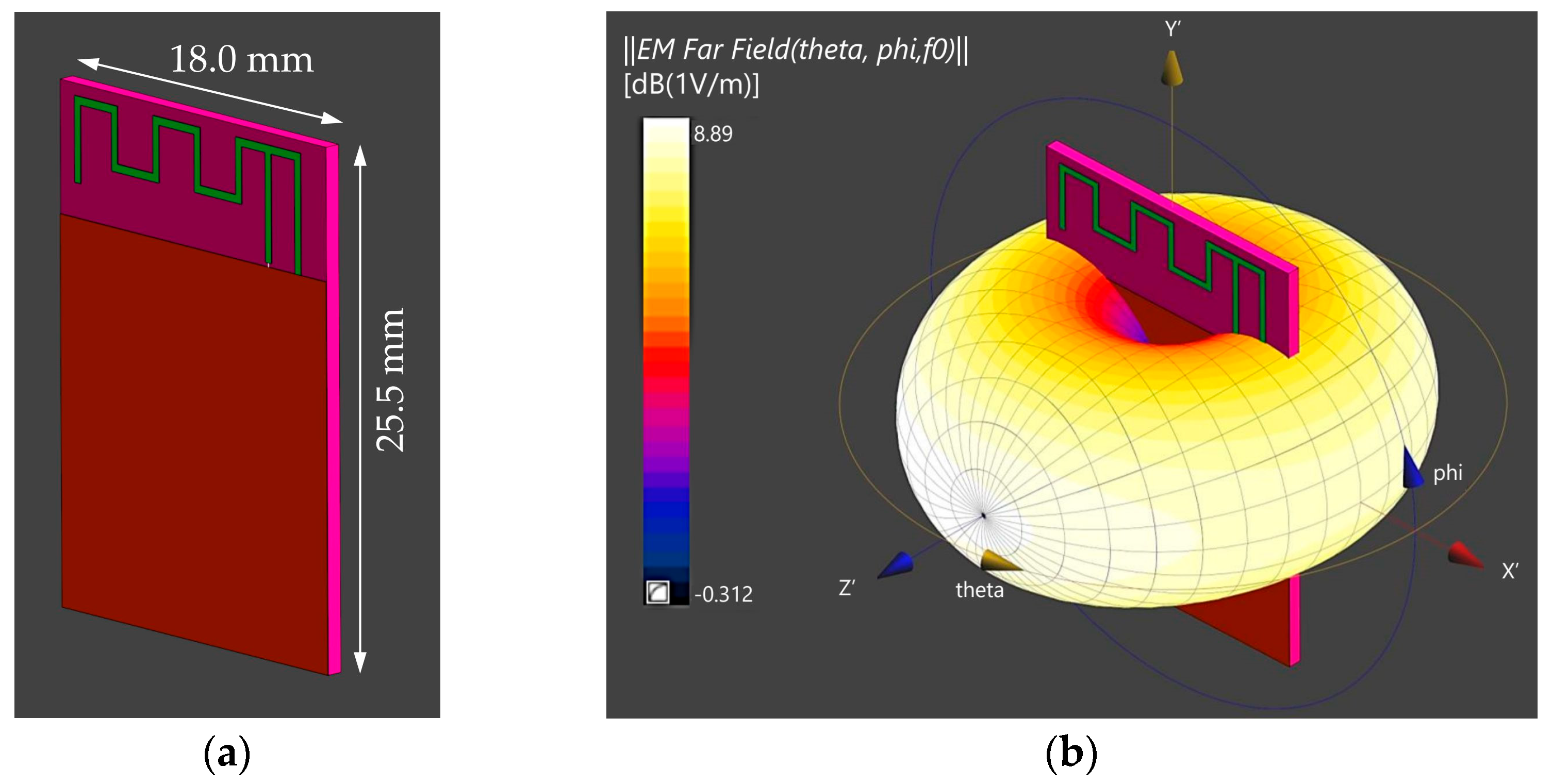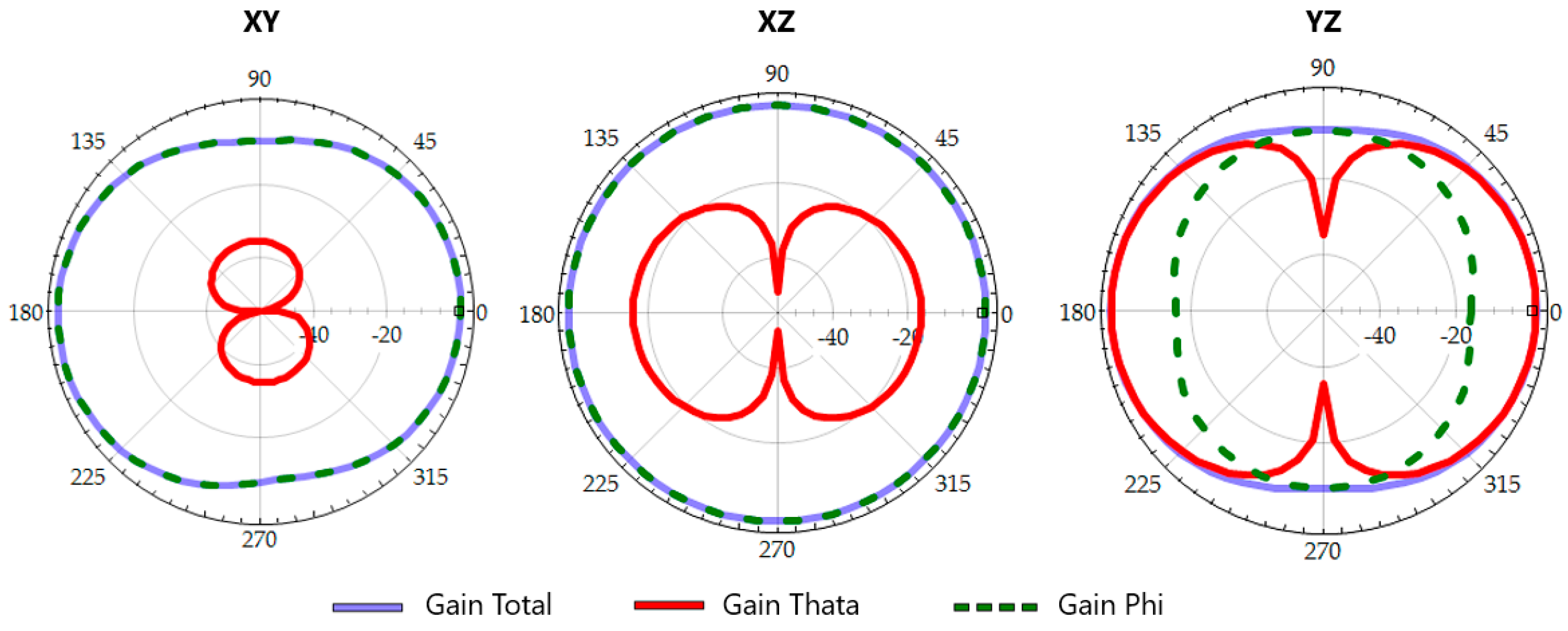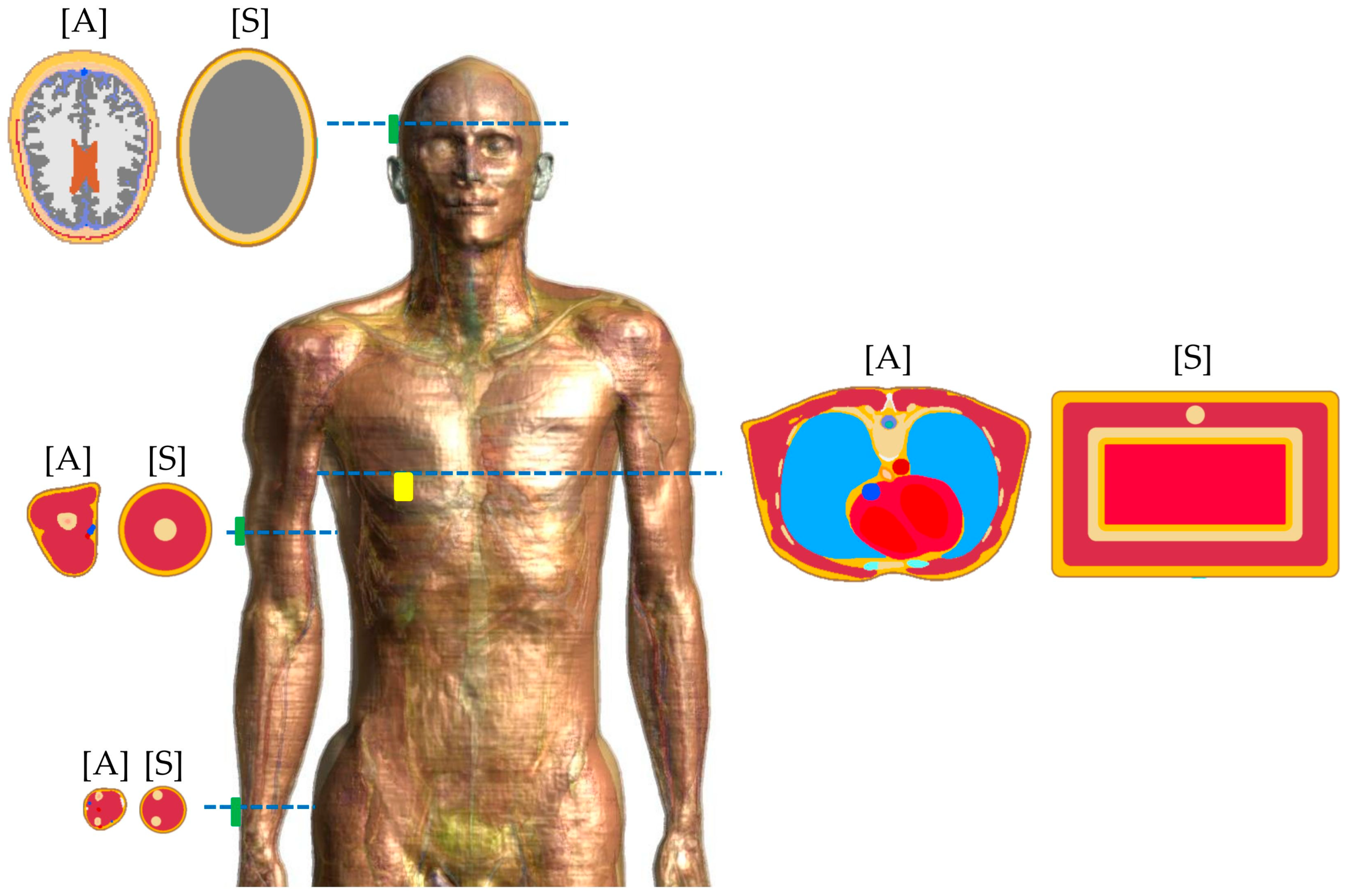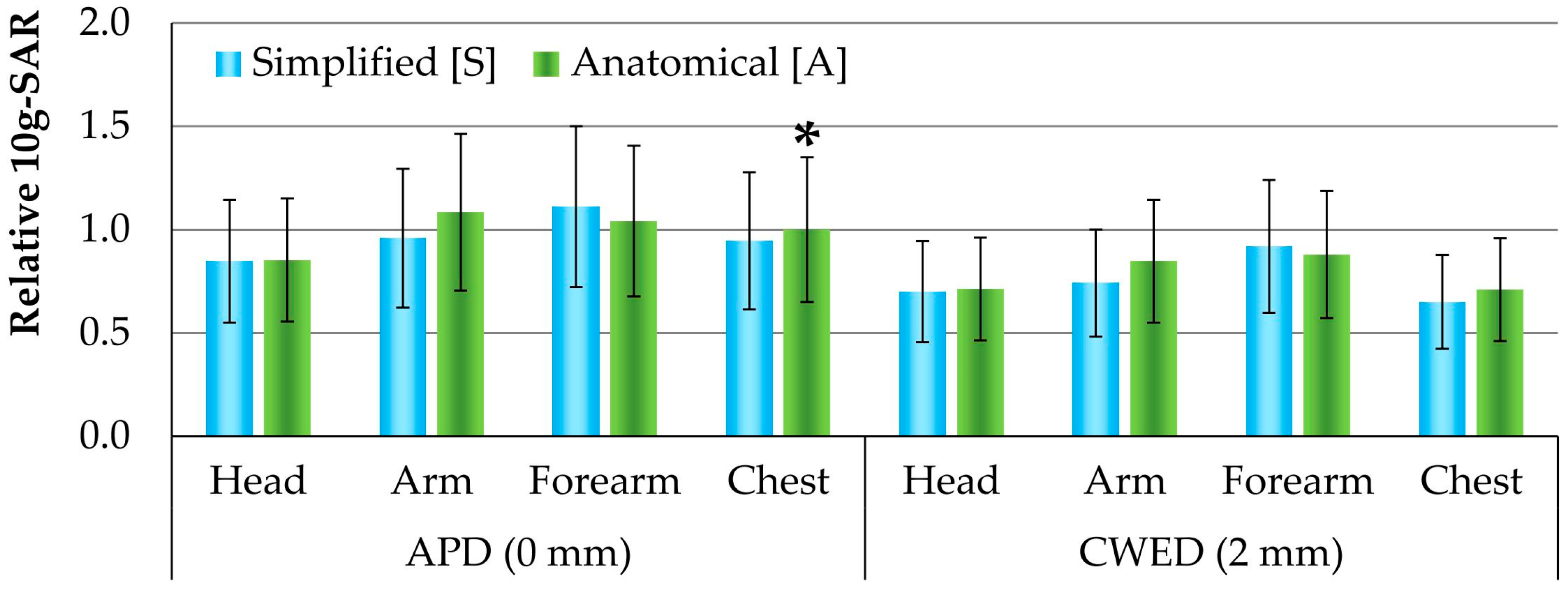The Parametrization of Electromagnetic Emissions and Hazards from a Wearable Device for Wireless Information Transfer with a 2.45 GHz ISM Band Antenna
Abstract
1. Introduction
Characteristics of the Considered WIT Systems Designed for Free-Space Operation in the 2.45 GHz ISM Band
- Maximum power (set by regulations for devices not requiring special administrative permission for use in a public environment)—from 1 mW (e.g., Bluetooth) to at least 4000 mW (e.g., SHF RFID);
- Duty cycle of the emitted signal—from 0.01 (e.g., SHF RFID) to 1.0 (e.g., Wi-Fi);
- The method in which WIT devices are used—portable devices, wearables, stationary devices mounted on infrastructure (e.g., walls, ceilings, poles, masts, or furniture), and devices mounted on or in vehicles, machines, etc.;
- Intended application—e.g., used in monitoring; remote control; real-time identification and localization/tracking (including WBANs in healthcare, asset and livestock tracking, sensor networks, or process control in industry); communication (including Machine to Machine); logistics (including vehicle management); smart cities, buildings, and factories; dangerous event detection; and remote meter reading, etc.
2. Materials and Methods
2.1. Assessment of Electromagnetic Hazards
- Whole-body average = 0.4 W/kg;
- Local 10g-SAR in head and torso = 10 W/kg;
- Local 10g-SAR in limbs = 20 W/kg.
2.2. Analysis of EMR Emissions from the WIT Device
2.3. Numerical Model of Wearable WIT Device
2.4. Numerical Models of the RCM User’s Body and Exposure Scenarios
2.5. Numerical Simulations
3. Results
3.1. Validation of the Numerical Models
3.2. Results Obtained at 100 mW (20 dBm) Input Power to the ARCM
3.2.1. The ARCM Parameters
3.2.2. Local 10g-SAR
4. Discussion
4.1. Analysis Regarding Devices Working with a Fixed Input Power to ARCM
4.1.1. ARCM Parameters
4.1.2. Local 10g-SAR
4.1.3. Anatomical Versus Simplified Body Models
4.2. Analysis Regarding Devices Working with a Fixed Eirp from the ARCM
4.3. Compliance Assessment with SAR Limits
4.4. Duty Cycle
5. Conclusions
Author Contributions
Funding
Institutional Review Board Statement
Informed Consent Statement
Data Availability Statement
Conflicts of Interest
Abbreviations
| ABC | Absorbing Boundary Conditions |
| APD | Adhesive Plaster Device |
| ARCM | Antenna of Radio Communication Module |
| BR | Basic Restrictions |
| CWED | Classic Wearable Electronic Device |
| DRL | Dosimetric Reference Limit |
| Eirp | Equivalent Isotopically Radiated Power |
| FDTD | Finite Difference Time Domain |
| HSPA+ | Evolved High-Speed Packet Access |
| ICNIRP | International Commission on Non-Ionizing Radiation Protection |
| IEEE | Institute of Electrical and Electronics Engineers |
| ISM | Industrial, Scientific, Medical |
| LTE | Long-Term Evolution |
| MIFA | Meandered Inverted-F Antenna |
| NB-IoT | Narrow Band Internet of Things |
| MW | MicroWave |
| RCM | Radio Communication Module |
| RED Directive | Directive 2014/53/EU |
| SAR | Specific Absorption Rate |
| SHF RFID | Super-High-Frequency Radio-Frequency IDentification |
| UMTS | Universal Mobile Telecommunications System |
| WBAN | Wireless Body-Area Network |
| Wi-Fi | Wireless-Fidelity |
| WIT | Wireless Information Transfer |
References
- Zradziński, P.; Karpowicz, J.; Gryz, K.; Morzyński, L.; Młyński, R.; Swidziński, A.; Godziszewski, K.; Ramos, V. Modelling the Influence of Electromagnetic Field on the User of a Wearable IoT Device Used in a WSN for Monitoring and Reducing Hazards in the Work Environment. Sensors 2020, 20, 7131. [Google Scholar] [CrossRef] [PubMed]
- Zradziński, P.; Karpowicz, J.; Gryz, K.; Owczarek, G.; Ramos, V. Modelling and Evaluation of the Absorption of the 866 MHz Electromagnetic Field in Humans Exposed near to Fixed I-RFID Readers Used in Medical RTLS or to Monitor PPE. Sensors 2021, 21, 4251. [Google Scholar] [CrossRef] [PubMed]
- Zradziński, P.; Karpowicz, J.; Gryz, K. Principles of evaluating the electromagnetic aspects of using wearable Internet of Things devices. Princ. Methods Assess. Work. Environ. 2022, 38, 7–38. [Google Scholar] [CrossRef]
- Zradziński, P.; Karpowicz, J.; Gryz, K. Evaluation of the electromagnetic circumstances of the use of wearable locators Principles and Methods of Assessing the Working Environment. Princ. Methods Assess. Work. Environ. 2022, 38, 65–78. [Google Scholar] [CrossRef]
- Ramos, V.; Suárez, O.J.; Suárez, S.; Febles, V.M.; Aguirre, E.; Zradziński, P.; Rabassa, L.E.; Celaya-Echarri, M.; Marina, P.; Karpowicz, J.; et al. Electromagnetic Assessment of UHF-RFID Devices in Healthcare Environment. Appl. Sci. 2022, 12, 10667. [Google Scholar] [CrossRef]
- Zradziński, P.; Karpowicz, J.; Gryz, K. Assessing the Antenna Performance (Radiated Power) and Electromagnetic Impact (SAR) on a User of a Wearable RF Communication Device, Involving Variously Structured Models. IEEE Access 2025, 13, 19257–19265. [Google Scholar] [CrossRef]
- Ashyap, A.Y.I.; Abidin, Z.Z.; Dahlan, S.H.; Majid, H.A.; Kamarudin, M.R.; Alomainy, A.; Abd-Alhameed, R.A.; Kosha, J.S.; Noras, J.M. Highly efficient wearable CPW antenna enabled by EBG-FSS structure for medical body area network applications. IEEE Access 2018, 6, 77529–77541. [Google Scholar] [CrossRef]
- Joseph, L.; Zradziński, P.; Chezhian, A.S.; Mandal, B.; Mani, M.; Voigt, T.; Karpowicz, J.; Perez, M.; Karlsson, R.L.; Augustine, R. Anthropomorphic Torso Phantoms and Validation of their Physical and Digital Twins for Body-Area Radio-Communication Applications. IEEE Trans. Biomed. Eng. 2025, 72, 1858–1871. [Google Scholar] [CrossRef]
- Kim, S.H.; Basir, A.; Avila, R.; Lim, J.; Hong, S.W.; Choe, G.; Shin, J.H.; Hwang, J.H.; Park, S.Y.; Joo, J.; et al. Strain-invariant stretchable radio-frequency electronics. Nature 2024, 629, 1047–1054. [Google Scholar] [CrossRef]
- Wang, M.; Yang, Z.; Wu, J.; Bao, J.; Liu, J.; Cai, L.; Dang, T.; Zheng, H.; Li, E. Investigation of SAR reduction using flexible antenna with metamaterial structure in wireless body area network. IEEE Trans. Antennas Propag. 2018, 66, 3076–3086. [Google Scholar] [CrossRef]
- Shah, S.M.; Rosman, A.A.; Rashid, M.A.Z.A.; Abidin, Z.Z.; Seman, F.C.; Majid, H.A.; Dahlan, S.H.; Hamzah, S.A.; Katiran, N.; Ponniran, A.; et al. A compact dual-band semi-flexible antenna at 2.45 GHz and 5.8 GHz for wearable applications. Bull. Electr. Eng. Informat. 2021, 10, 1739–1746. [Google Scholar] [CrossRef]
- Krzemiński, J.; Baraniecki, D.; Dominiczak, J.; Wojciechowska, I.; Raczyński, T.; Janczak, D.; Jakubowska, M. Hybrid Printing of Silver-Based Inks for Application in Flexible Printed Sensors. Crystals 2023, 13, 720. [Google Scholar] [CrossRef]
- Lepak-Kuc, S.; Kądziela, A.; Staniszewska, M.; Janczak, D.; Jakubowska, M.; Bednarczyk, E.; Murawski, T.; Piłczyńska, K.; Żołek-Tryznowska, Z. Sustainable, cytocompatible and flexible electronics on potato starch-based films. Sci. Rep. 2024, 14, 18838. [Google Scholar] [CrossRef]
- Szałapak, J.; Zdanikowski, B.; Kądziela, A.; Lepak-Kuc, S.; Dybowska-Sarapuk, Ł.; Janczak, D.; Raczyński, T.; Jakubowska, M. Carbon-Based Composites with Biodegradable Matrix for Flexible Paper Electronics. Polymers 2024, 16, 686. [Google Scholar] [CrossRef] [PubMed]
- Iman, U.R.; Zada, M.; Basir, A.; Hayat, S.; Lim, Y.-H.; Yoo, H. IoT-Enabled Real-Time Health Monitoring via Smart Textile Integration With LoRa Technology Across Diverse Environments. IEEE Trans. Industr. Inform. 2024, 20, 12803–12813. [Google Scholar] [CrossRef]
- International Electrotechnical Commission (IEC)/Institute of Electrical and Electronics Engineers (IEEE) 62704-1:2017; Determining the Peak Spatial-Average Specific Ab-Sorption Rate (SAR) in the Human Body from Wireless Communications Devices, 30 MHz to 6 GHz—Part 1: General Requirements for Using the Finite-Difference Time-Domain (FDTD) Method for SAR Calculations. IEC: Geneva, Switzerland, 2017.
- International Commission on Non-Ionizing Radiation Protection (ICNIRP). Guidelines for limiting exposure to electro-magnetic fields (100 kHz to 300 GHz). Health Phys. 2020, 118, 483–524. [Google Scholar] [CrossRef]
- Hazarika, B.; Basu, B.; Nandi, A. An artificial magnetic conductor-backed monopole antenna to obtain high gain, conformability, and lower specific absorption rate for WBAN applications. Int. J. RF Microw. Comput. Aided Eng. 2020, 30, e22441. [Google Scholar] [CrossRef]
- Nguyen, D.; Seo, C. An Ultra-Miniaturized Antenna Using Loading Circuit Method for Medical Implant Applications. IEEE Access 2021, 9, 111890–111898. [Google Scholar] [CrossRef]
- Yan, S.; Soh, P.J.; Vandenbosch, G.A.E. Low-Profile Dual-Band Textile Antenna with Artificial Magnetic Conductor Plane. IEEE Trans. Antennas Propag. 2014, 62, 6487–6490. [Google Scholar] [CrossRef]
- Casula, G.A.; Montisci, G. A Design Rule to Reduce the Human Body Effect on Wearable PIFA Antennas. Electronics 2019, 8, 244. [Google Scholar] [CrossRef]
- Directive 2014/53/EU of the European Parliament and of the Council. Directive 2014/53/EU of the european parliament and of the council of 16 April 2014 on the harmonisation of the laws of the member states relating to the making available on the market of radio equipment and repealing directive 1999/5/EC text with EEA relevance. Off. J. Eur. Union. 2014, L 153, 62–106. [Google Scholar]
- European Telecommunications Standards Institute (ETSI) EN 300 328 v2.2.2 (2019-07); Wideband Transmission Systems; Data Transmission Equipment Operating in the 2,4 GHz Band; Harmonised Standard for Access To Radio Spectrum. ETSI: Sophia Antipolis, France, 2019.
- European Telecommunications Standards Institute (ETSI) TS 136 101 V18.6.0 (2024-08); LTE; Evolved Universal Terrestrial Radio Access (E-UTRA); User Equipment (UE) Radio Transmission and Reception (3GPP TS 36.101 Version 18.6.0 Release 18). ETSI: Sophia Antipolis, France, 2024.
- European Telecommunications Standards Institute (ETSI) TS 125 101 V15.3.0 (2019-05); Universal Mobile Telecommunications System (UMTS); User Equipment (UE) Radio Transmission and Reception (FDD) (3GPP TS 25.101 Version 15.3.0 Release 15). ETSI: Sophia Antipolis, France, 2019.
- European Telecommunications Standards Institute (ETSI) EN 300 440 V2.1.1 (2017-03); Short Range Devices (SRD); Radio Equipment to Be Used in the 1 GHz to 40 GHz Frequency Range; Harmonised Standard Covering the Essential Requirements of Article 3.2 of Directive 2014/53/EU. ETSI: Sophia Antipolis, France, 2017.
- European Telecommunications Standards Institute (ETSI) TR 103 711 V1.1.1 (2020-10); Smart Body Area Network (SmartBAN); Applying SmartBAN MAC (ETSI TS 103 325) for Various Use-Cases. ETSI: Sophia Antipolis, France, 2020.
- Institute of Electrical and Electronics Engineers (IEEE) C95.1-2019; IEEE Standard for Safety Levels With Respect To Human Exposure To Electric, Magnetic, and Electromagnetic Fields, 0 Hz To 300 GHz. IEEE: New York, NY, USA, 2019.
- Ahmad, A.; Faisal, F.; Ullah, S.; Choi, D.-Y. Design and SAR Analysis of a Dual Band Wearable Antenna for WLAN Applications. Appl. Sci. 2022, 12, 9218. [Google Scholar] [CrossRef]
- Gosselin, M.-C.; Neufeld, E.; Moser, H.; Huber, E.; Farcito, S.; Gerber, L.; Jedensjö, M.; Hilber, I.; Di Gennaro, F.; Lloyd, B.; et al. Development of a new generation of high-resolution anatomical models for medical device evaluation: The Virtual Population 3.0. Phys. Med. Biol. 2014, 59, 5287. [Google Scholar] [CrossRef] [PubMed]
- Gedliczka, A. Atlas Miar Czowieka-Dane Do Projektowania I Oceny Ergonomicznej [Atlas of Human Body Measures-Data Sheets for Ergonomic and Evaluation]; Central Institute for Labour Protection: Warsaw, Poland, 2001. [Google Scholar]
- Ruan, J.; Prasad, P. The effects of skull thickness variations on human head dynamic impact responses. Stapp. Car Crash J. 2001, 45, 395–414. [Google Scholar] [CrossRef]
- International Electrotechnical Commission (IEC) 62232-2022; Determination of RF Field Strength, Power Density and SAR in the Vicinity of Base Stations for the Purpose of Evaluating Human Exposure. IEC: Geneva, Switzerland, 2022.
- Joseph, W.; Pareit, D.; Vermeeren, G.; Naudts, D.; Verloock, L.; Martens, L.; Moerman, I. Determination of the duty cycle of WLAN for realistic radio frequency electromagnetic field exposure assessment. Prog. Biophys. Mol. Biol. 2013, 111, 30–36. [Google Scholar] [CrossRef] [PubMed]








| System | Frequency Band [MHz] | Max Eirp 2 [mW] | Duty Cycle 3 | References |
|---|---|---|---|---|
| Wi-Fi 2G | 2400–2483.5 | 100 (Class 1) | 0.02–0.95 | ETSI EN 300 328 V2.2.2 (2019-07) [23] |
| LTE; LTE-M; NB-IoT | 1880–1920; 1920–1980; 2110–2170; 2300–2400; 2496–2690 | 1250 (Class 1); 200 (Class 3) | 0.02–0.95 | ETSI TS 136 101 V18.6.0 (2024-08) [24] |
| UMTS; HSPA+ | 1885–2025; 2110–2200 | 2000 | 0.02–0.95 | ETSI TS 125 101 V15.3.0 (2019-05) [25] |
| Bluetooth (LE); ZigBee | 2400–2483.5 | 100 (Class 1); 2.5 (Class 2); 1 (Class 3) | ETSI EN 300 328 V2.2.2 (2019-07) [23] | |
| SHF RFID | 2446–2454 | 500 (4000 in building) | 0.01–0.7 (0.01–0.15 in building) | ETSI EN 300 440 V2.1.1 (2017-03) [26] |
| WBAN | 2360–2400; 2400–2483.5 | 1 | <0.1 | ETSI TR 103 711 V1.1.1 (2020-10) [27] |
| Material/Tissue | εr | σ, S/m | Density, kg/m3 |
|---|---|---|---|
| The numerical model of the RCM equipped with MIFA | |||
| Copper | 1.0 | 5.8 × 107 | 8930 |
| FR-4 | 4.0 | 3.8 × 10−3 | 1850 |
| The simplified numerical models of body parts | |||
| Bone | 11 | 0.39 | 1910 |
| Brain | 43 | 1.8 | 1040 |
| Fat | 11 | 0.27 | 910 |
| Internal organ | 55 | 2.5 | 1060 |
| Muscle | 53 | 2.2 | 1090 |
| Skin | 38 | 1.5 | 1110 |
| Part of the Body | Outer Dimensions [mm] | Tissue (Thickness [mm]) |
|---|---|---|
| Head | 238 × 159 × 190 | Skin (4); Fat (4); Bone (8); Brain (Inner part) |
| Arm | Ø 105 × 340 | Skin (2); Fat (5); Bone (Ø 25); Muscle (Inner part) |
| Forearm | Ø 56(90) × 260 | Skin (2); Fat (2); Bone (Ø 15); Muscle (Inner part) |
| Chest | 320 × 188 × 200 | Skin (2); Fat (12); Muscle (30); Bone (10); Fat (10); Internal organ (Inner part); Bone (Ø 22) |
| Exposure Scenario | Measurement (Simulation) | |
|---|---|---|
| Resonant Frequency [GHz] | S11@2.45 GHz [dB] | |
| Free space | 2.400 (2.432) | −6.01 (−5.85) |
| APD 1 on the arm | 1.545 (1.602) | −0.914 (−0.849) |
| APD 1 on the forearm | 1.595 (1.631) | −0.865 (−0.926) |
| CWED 2 on the chest | 2.210 (2.208) | −3.13 (−3.53) |
| Scenario | Simplified [S] (Anatomical [A]) Model of User’s Body | ||||
|---|---|---|---|---|---|
| Resonant Frequency [GHz] | S11@2.45 GHz [dB] | Gain [dB] | eirp 1 [dBm] | 10g-SAR [W/kg] | |
| APD exposure scenario (RCM located directly on the body: 0 mm distance between the RCM and the body) | |||||
| Head | 1.537 (1.562) | −0.837 (−0.886) | −17.5 (−14.3) | 2.43 (5.66) | 4.73 (4.76) |
| Arm | 1.551 (1.602) | −0.847 (−0.849) | −11.0 (−10.7) | 9.02 (9.26) | 5.35 (6.05) |
| Forearm | 1.561 (1.631) | −0.992 (−0.926) | −9.44 (−10.7) | 10.6 (9.26) | 6.20 (5.81) |
| Chest | 1.365 (1.359) | −0.640 (−0.561) | −17.1 (−16.2) | 2.89 (3.76) | 5.28 (5.58) |
| CWED exposure scenario (RCM located 2 mm away from the body surface) | |||||
| Head | 2.159 (2.155) | −3.25 (−3.95) | −12.1 (−8.96) | 7.87 (11.1) | 3.91 (3.98) |
| Arm | 2.223 (2.260) | −4.07 (−4.24) | −8.56 (−7.80) | 11.4 (12.2) | 4.14 (4.73) |
| Forearm | 2.214 (2.243) | −3.66 (−3.82) | −5.83 (−6.59) | 14.2(13.4) | 5.13 (4.91) |
| Chest | 2.208 (2.169) | −3.53 (−3.21) | −12.4 (−11.9) | 7.56 (8.14) | 3.63 (3.96) |
Disclaimer/Publisher’s Note: The statements, opinions and data contained in all publications are solely those of the individual author(s) and contributor(s) and not of MDPI and/or the editor(s). MDPI and/or the editor(s) disclaim responsibility for any injury to people or property resulting from any ideas, methods, instructions or products referred to in the content. |
© 2025 by the authors. Licensee MDPI, Basel, Switzerland. This article is an open access article distributed under the terms and conditions of the Creative Commons Attribution (CC BY) license (https://creativecommons.org/licenses/by/4.0/).
Share and Cite
Zradziński, P.; Karpowicz, J.; Gryz, K. The Parametrization of Electromagnetic Emissions and Hazards from a Wearable Device for Wireless Information Transfer with a 2.45 GHz ISM Band Antenna. Appl. Sci. 2025, 15, 6602. https://doi.org/10.3390/app15126602
Zradziński P, Karpowicz J, Gryz K. The Parametrization of Electromagnetic Emissions and Hazards from a Wearable Device for Wireless Information Transfer with a 2.45 GHz ISM Band Antenna. Applied Sciences. 2025; 15(12):6602. https://doi.org/10.3390/app15126602
Chicago/Turabian StyleZradziński, Patryk, Jolanta Karpowicz, and Krzysztof Gryz. 2025. "The Parametrization of Electromagnetic Emissions and Hazards from a Wearable Device for Wireless Information Transfer with a 2.45 GHz ISM Band Antenna" Applied Sciences 15, no. 12: 6602. https://doi.org/10.3390/app15126602
APA StyleZradziński, P., Karpowicz, J., & Gryz, K. (2025). The Parametrization of Electromagnetic Emissions and Hazards from a Wearable Device for Wireless Information Transfer with a 2.45 GHz ISM Band Antenna. Applied Sciences, 15(12), 6602. https://doi.org/10.3390/app15126602









